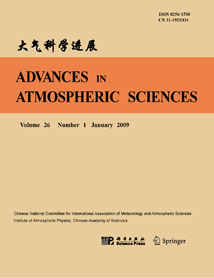| [1] |
Jiangyu MAO, Ming WANG,
2018: The 30-60-day Intraseasonal Variability of Sea Surface Temperature in the South China Sea during May-September, ADVANCES IN ATMOSPHERIC SCIENCES, 35, 550-566.
doi: 10.1007/s00376-017-7127-x
|
| [2] |
ZHAO Xia, LI Jianping, ZHANG Wenjun,
2012: Summer Persistence Barrier of Sea Surface Temperature Anomalies in the Central Western North Pacific, ADVANCES IN ATMOSPHERIC SCIENCES, 29, 1159-1173.
doi: 10.1007/s00376-012-1253-2
|
| [3] |
HU Dingzhu, TIAN Wenshou, XIE Fei, SHU Jianchuan, and Sandip DHOMSE, ,
2014: Effects of Meridional Sea Surface Temperature Changes on Stratospheric Temperature and Circulation, ADVANCES IN ATMOSPHERIC SCIENCES, 31, 888-900.
doi: 10.1007/s00376-013-3152-6
|
| [4] |
CHEN Xiao, YAN Youfang, CHENG Xuhua, QI Yiquan,
2013: Performances of Seven Datasets in Presenting the Upper Ocean Heat Content in the South China Sea, ADVANCES IN ATMOSPHERIC SCIENCES, 30, 1331-1342.
doi: 10.1007/s00376-013-2132-1
|
| [5] |
Xue Feng,
2001: Interannual to Interdecadal Variation of East Asian Summer Monsoon and its Association with the Global Atmospheric Circulation and Sea Surface Temperature, ADVANCES IN ATMOSPHERIC SCIENCES, 18, 567-575.
doi: 10.1007/s00376-001-0045-x
|
| [6] |
Li Wei, Yu Rucong, Zhang Xuehong,
2001: Impacts of Sea Surface Temperature in the Tropical Pacific on Interannual Variability of Madden-Julian Oscillation in Precipitation, ADVANCES IN ATMOSPHERIC SCIENCES, 18, 429-444.
doi: 10.1007/BF02919322
|
| [7] |
HU Wenting, WU Renguang,
2015: Relationship between South China Sea Precipitation Variability and Tropical Indo-Pacific SST Anomalies in IPCC CMIP5 Models during Spring-to-Summer Transition, ADVANCES IN ATMOSPHERIC SCIENCES, 32, 1308-1318.
doi: 10.1007/s00376-015-4250-4
|
| [8] |
WANG Xin, ZHOU Wen, LI Chongyin, WANG Dongxiao,
2012: Effects of the East Asian Summer Monsoon on Tropical Cyclone Genesis over the South China Sea on an Interdecadal Time Scale, ADVANCES IN ATMOSPHERIC SCIENCES, 29, 249-262.
doi: 10.1007/s00376-011-1080-x
|
| [9] |
Liu Qinyu, Jia Yinglai, Wang Xiaohua, Yang Haijun,
2001: On the Annual Cycle Characteristics of the Sea Surface Height in South China Sea, ADVANCES IN ATMOSPHERIC SCIENCES, 18, 613-622.
doi: 10.1007/s00376-001-0049-6
|
| [10] |
Peter C. Chu, C.-P. Chang,
1997: South China Sea Warm Pool in Boreal Spring, ADVANCES IN ATMOSPHERIC SCIENCES, 14, 195-206.
doi: 10.1007/s00376-997-0019-8
|
| [11] |
Yueliang CHEN, Changxiang YAN, Jiang ZHU,
2018: Assimilation of Sea Surface Temperature in a Global Hybrid Coordinate Ocean Model, ADVANCES IN ATMOSPHERIC SCIENCES, 35, 1291-1304.
doi: 10.1007/s00376-018-7284-6
|
| [12] |
SUN Jianqi, YUAN Wei,
2009: Contribution of the Sea Surface Temperature over the Mediterranean-Black Sea to the Decadal Shift of the Summer North Atlantic Oscillation, ADVANCES IN ATMOSPHERIC SCIENCES, 26, 717-726.
doi: 10.1007/s00376-009-8210-8
|
| [13] |
ZHOU Lian-Tong, Chi-Yung TAM, ZHOU Wen, Johnny C. L. CHAN,
2010: Influence of South China Sea SST and the ENSO on Winter Rainfall over South China, ADVANCES IN ATMOSPHERIC SCIENCES, 27, 832-844.
doi: 10.1007/s00376--009-9102-7
|
| [14] |
Lu Riyu, Chan-Su Ryu, Buwen Dong,
2002: Associations between the Western North Pacific Monsoon and the South China Sea Monsoon, ADVANCES IN ATMOSPHERIC SCIENCES, 19, 12-24.
doi: 10.1007/s00376-002-0030-z
|
| [15] |
Haoya LIU, Weibiao LI, Shumin CHEN, Rong FANG, Zhuo LI,
2018: Atmospheric Response to Mesoscale Ocean Eddies over the South China Sea, ADVANCES IN ATMOSPHERIC SCIENCES, 35, 1189-1204.
doi: 10.1007/s00376-018-7175-x
|
| [16] |
Yan Junyue,
1997: Observational Study on the Onset of the South China Sea Southwest Monsoon, ADVANCES IN ATMOSPHERIC SCIENCES, 14, 277-287.
doi: 10.1007/s00376-997-0026-9
|
| [17] |
Hailong LIU, Pingxiang Chu, Yao Meng, Mengrong DING, Pengfei LIN, Ruiqiang Ding, Pengfei Wang, Weipeng ZHENG,
2024: The Predictability Limit of Oceanic Mesoscale Eddy Tracks in the South China Sea, ADVANCES IN ATMOSPHERIC SCIENCES.
doi: 10.1007/s00376-024-3250-7
|
| [18] |
Yang Haijun, Liu Qinyu, Jia Xujing,
1999: On the Upper Oceanic Heat Budget in the South China Sea: Annual Cycle, ADVANCES IN ATMOSPHERIC SCIENCES, 16, 619-629.
doi: 10.1007/s00376-999-0036-x
|
| [19] |
Shuai WANG, Ralf TOUMI,
2018: Reduced Sensitivity of Tropical Cyclone Intensity and Size to Sea Surface Temperature in a Radiative-Convective Equilibrium Environment, ADVANCES IN ATMOSPHERIC SCIENCES, 35, 981-993.
doi: 10.1007/s00376-018-7277-5
|
| [20] |
Yan XIA, Yongyun HU, Jiankai ZHANG, Fei XIE, Wenshou TIAN,
2021: Record Arctic Ozone Loss in Spring 2020 is Likely Caused by North Pacific Warm Sea Surface Temperature Anomalies, ADVANCES IN ATMOSPHERIC SCIENCES, 38, 1723-1736.
doi: 10.1007/s00376-021-0359-9
|















 AAS Website
AAS Website 
 AAS WeChat
AAS WeChat 
 DownLoad:
DownLoad: